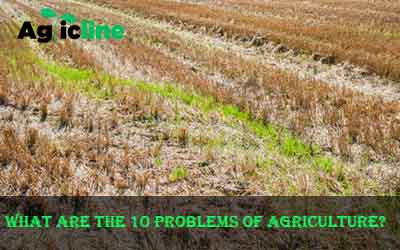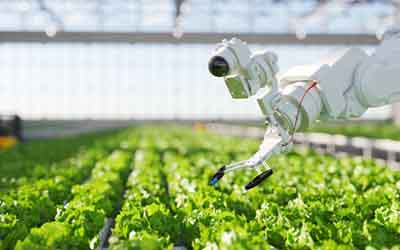The importance of agriculture can never be overestimated. Amidst these benefits accruing from it the challenges remain prominent which have left many with the question of what are the 10 problems of agriculture.
These agricultural challenges are far from inconsequential; they impact not only the millions of farmers who toil the land but also ripple across the entire spectrum of society.
Today, I bring to you the ten major problems that agriculture faces today and explore potential solutions to address them. From soil degradation to climate change, from water scarcity to limited access to credit, these issues not only threaten food security but also have far-reaching economic and environmental implications.
Sit tight and fasten your seat belt as we embark on this journey to understand the various problems of agriculture, it becomes apparent that finding solutions to these challenges is not just the responsibility of farmers alone but a shared commitment that involves governments, industries, researchers, and consumers.
What are the 10 problems of agriculture?
- Soil Degradation
- Water Scarcity
- Pests and Diseases
- Climate Change
- Lack of Modern Technology
- Post-Harvest Losses
- Inadequate Market Access
- Limited Access to Credit and Capital
- Land Ownership and Land Grabs
- Insufficient Agricultural Education and Training
1. Soil Degradation
Soil degradation, often referred to as the silent crisis of agriculture, is a pressing concern that threatens the very foundation of our food production systems.
This problem arises when the quality and fertility of soil deteriorate over time, leading to reduced agricultural productivity and, ultimately, food insecurity. Understanding the causes and potential solutions to soil degradation is critical in safeguarding our ability to feed the global population sustainably.
Causes of Soil Degradation
- Over-Farming
- Use of Chemical Fertilizers
- Soil Erosion
- Deforestation
Potential Solutions
- Crop Rotation
- Organic Farming
- Conservation Tillage
- Agroforestry
- Soil Testing and Monitoring
- Government Policies and Education
2. Water Scarcity
Water scarcity is an escalating global crisis that poses a significant threat to agriculture, ecosystems, and human societies. As the demand for freshwater continues to rise due to population growth, industrialization, and urbanization, it’s crucial to address the challenges associated with water scarcity in the context of agriculture.

The Increasing Problem of Water Shortages
Water scarcity occurs when the demand for freshwater exceeds the available supply. In many regions, agriculture is the largest consumer of freshwater resources, accounting for approximately 70% of global water withdrawals. However, the following factors contribute to the intensification of water scarcity in agriculture:
- Population Growth
- Climate Change
- Inefficient Water Use
- Pollution
Solutions to Water Scarcity
- Rainwater Harvesting
- Efficient Irrigation Methods
- Improved Water Management
- Crop Selection and Rotation
- Government Regulations
- Education and Training
- Research and Technology
3. Pests and Diseases
Pests and diseases represent a perpetual threat to global agriculture, capable of causing extensive damage to crops and disrupting food production systems.

Common Pests and Diseases in Agriculture
- Insects
- Fungi
- Bacteria
- Viruses
- Nematodes
- Weeds
Modern Methods of Pest and Disease Control (Integrated Pest Management – IPM)
Integrated Pest Management (IPM) is a holistic approach to pest and disease control that combines various strategies to minimize their impact while reducing the use of chemical pesticides. Here are the key components of IPM:
- Monitoring and Scouting
- Cultural Practices
- Biological Control
- Mechanical Control
- Chemical Control (as a Last Resort
- Resistant Varieties
- Education and Training
- Data and Technology
4. Climate Change
Climate change is an undeniable reality that is significantly impacting agriculture worldwide. Changing weather patterns, rising temperatures, and extreme weather events have created a host of challenges for farmers and food security. In this section, we will explore how climate change affects agriculture and examine strategies for climate-resilient farming.
How Changing Weather Patterns Affect Agriculture
- Erratic Rainfall
- Temperature Extremes
- Pests and Diseases
- Shifts in Growing Seasons
Strategies for Climate-Resilient Farming
- Diversification of Crops
- Improved Water Management
- Crop Selection
- Conservation Agriculture
- Livestock Management
- Weather Forecasting and Early Warning Systems
- Sustainable Land Management
5. Lack of Modern Technology
The adoption of modern agricultural practices and technologies varies widely across the agricultural landscape, creating disparities in productivity, resource efficiency, and overall sustainability.
Disparity in the Adoption of Modern Agricultural Practices and Technologies
- Access to Information
- Financial Constraints
- Infrastructure Limitations
- Education and Training
- Cultural Resistance
The Potential of Technology in Revolutionizing Agriculture (e.g., Precision Farming)
Modern technology has the power to revolutionize agriculture by improving efficiency, sustainability, and overall productivity.
One such technological advancement is Precision Farming, which involves the use of data, sensors, and automation to optimize farming operations. Here’s how precision farming can transform agriculture:
- Data-Driven Decision Making
- Resource Efficiency
- Automation and Robotics
- Climate Adaptation
- Sustainability
- Improved Crop Quality
- Market Access
- Empowerment of Smallholders
6. Post-Harvest Losses
Post-harvest losses represent a significant challenge in agriculture, contributing to food insecurity, economic losses, and environmental waste. In this section, we will explore the magnitude of post-harvest losses due to improper storage and transportation, and discuss potential solutions, including the establishment of better storage facilities and cold chains.
Statistics on Post-Harvest Losses
Post-harvest losses occur at various stages, from the point of harvest to the consumer’s plate, and can encompass damage, spoilage, and waste. The statistics on post-harvest losses highlight the urgency of addressing this issue:
- Global Food Losses
- Losses in Developing Countries
- Economic Impact
- Environmental Consequences
Solutions to Post-Harvest Losses
Addressing post-harvest losses requires a combination of improved infrastructure, technology, and good agricultural practices. Here are some solutions to mitigate these losses:
- Better Storage Facilities
- Cold Chains
- Packaging and Handling
- Post-Harvest Technologies
- Education and Training
- Market Access
- Innovation and Research
- Government Policies
- Reducing Food Waste
7. Inadequate Market Access
Inadequate market access is a pervasive challenge that many farmers, particularly smallholders and rural producers, face worldwide. This issue prevents farmers from reaching broader, more profitable markets for their agricultural products.
Challenges Farmers Face in Accessing Broader, Profitable Markets
- Geographic Isolation
- Information Asymmetry
- Limited Bargaining Power
- Market Intermediaries
- Quality and Standards
Digital Platforms and Cooperatives as Potential Solutions:
- Digital Marketplaces
- e-Commerce
- Market Information Systems
- Cooperatives
- Capacity Building
- Financial Inclusion
- Government Support
- Value Addition
- Fair Trade and Certification
- Research and Innovation
8. Limited Access to Credit and Capital
Limited access to credit and capital is a significant impediment to the growth, expansion, and modernization of agriculture, particularly for small-scale farmers and rural communities.
How Lack of Funds Limits Agricultural Expansion and Modernization
- Limited Investment
- Crop Diversification
- Infrastructure Development
- Risk Management
- Adoption of Technology
9. Microfinancing and Government Schemes as Possible Remedies
- Microfinancing
- Government-Backed Credit Programs
- Agricultural Cooperatives
- Crop Insurance
- Rural Development Initiatives
- Financial Literacy and Training
- Private Sector Partnerships
- Support for Agribusiness
Land Ownership and Land Grabs
Land ownership and land grabs are contentious issues in agriculture, particularly in developing countries. Unclear land rights and large-scale land acquisitions can have profound social, economic, and environmental consequences.
Issues of Unclear Land Rights
- Insecurity
- Reduced Investment
- Environmental Degradation
- Impediments to Credit Access
Large-Scale Land Acquisitions (Land Grabs)
- Displacement of Communities
- Loss of Food Security
- Environmental Impact
- Economic Exploitation
Importance of Clear Land Tenure Systems
- Security and Stability
- Economic Development
- Social Harmony
- Environmental Conservation
10. Insufficient Agricultural Education and Training
Insufficient agricultural education and training present a significant hurdle to the progress of agriculture, particularly in developing regions.
The gap in knowledge and skills among farmers hinders their ability to adopt modern practices, improve productivity, and address complex challenges.
The Gap in Knowledge and Skills Among Farmers
- Traditional Farming Practices
- Limited Access to Information
- Technological Divide
- Sustainability Challenges
- Risk Management
- Entrepreneurship and Market Access
Advocacy for More Agricultural Training Programs and Institutions
- Expansion of Agricultural Education
- Extension Services
- Vocational and Technical Training
- Digital Learning
- Farmers’ Organizations
- Research and Development
- Public-Private Partnerships
- Tailored Training
Problems facing agriculture in developing countries
Agriculture remains a crucial sector for the majority of developing countries, providing employment for a significant portion of the population and playing a critical role in food security, rural development, and exports.
However, agriculture in these nations faces numerous challenges that hamper productivity, sustainability, and growth. This article seeks to explore some of the most pressing problems facing agriculture in developing countries:
- Lack of Modern Technology and Infrastructure
Many farmers in developing countries still use outdated farming techniques due to lack of access to modern technology. Poor infrastructure, including roads and storage facilities, makes it difficult for farmers to store produce effectively and transport it to markets.
- Financial Constraints
Farmers often lack access to credit facilities or have high interest rates, which inhibits their ability to invest in farming operations.
Smallholder farmers face difficulties in accessing insurance, leaving them vulnerable to crop losses.
- Land Degradation and Soil Fertility Issues
Uncontrolled deforestation, unsustainable farming practices, and overgrazing lead to soil erosion and degradation.
Continuous farming without appropriate soil conservation measures reduces soil fertility over time.
- Water Scarcity and Poor Irrigation
Many regions face irregular rainfall patterns due to climate change, leading to water scarcity issues.
Existing irrigation systems are often inefficient, leading to wasted water and reduced yields.
- Pests and Diseases
Due to limited access to pest control techniques and information, crops in developing nations are more susceptible to pests and diseases. This results in significant yield reductions and food insecurity.
- Limited Access to Markets
Smallholder farmers often face challenges in accessing larger, more profitable markets due to lack of information, poor infrastructure, and intermediaries.
- Climate Change and Variability
Extreme weather events such as droughts, floods, and unpredictable rainfall patterns have become more common due to climate change. These changes threaten agricultural productivity and food security in developing countries.
- Inadequate Training and Education
Many farmers lack formal education and training in modern agricultural techniques, leading to reduced productivity and sustainability.
- Land Tenure and Ownership Issues
In some countries, unclear land ownership rights discourage farmers from investing in long-term improvements or adopting sustainable farming practices. Land grabbing and conflicts over land rights can also be significant challenges.
- Policy and Institutional Challenges
Inconsistent agricultural policies can deter long-term investment in the sector. Corruption, poor governance, and lack of support for the agricultural sector hinder growth and sustainability.
Concluding remark on what are the 10 problems of agriculture
In this comprehensive exploration of the challenges facing agriculture, we have highlighted ten pressing problems and discussed potential solutions to each.
Agriculture, as the backbone of food production and a significant contributor to global economies, faces complex and multifaceted challenges. However, with concerted efforts from governments, organizations, and individuals, these challenges can be addressed, leading to a more sustainable and prosperous future for agriculture and society as a whole.
Addressing these challenges requires collective action and commitment from governments, organizations, and individuals.
Recommendations
7 Best Methods of pest control in agriculture
What is the green revolution in agriculture?
Best precision agriculture technologies
Artificial intelligence in agriculture projects (You don’t want to miss reading about this one)



